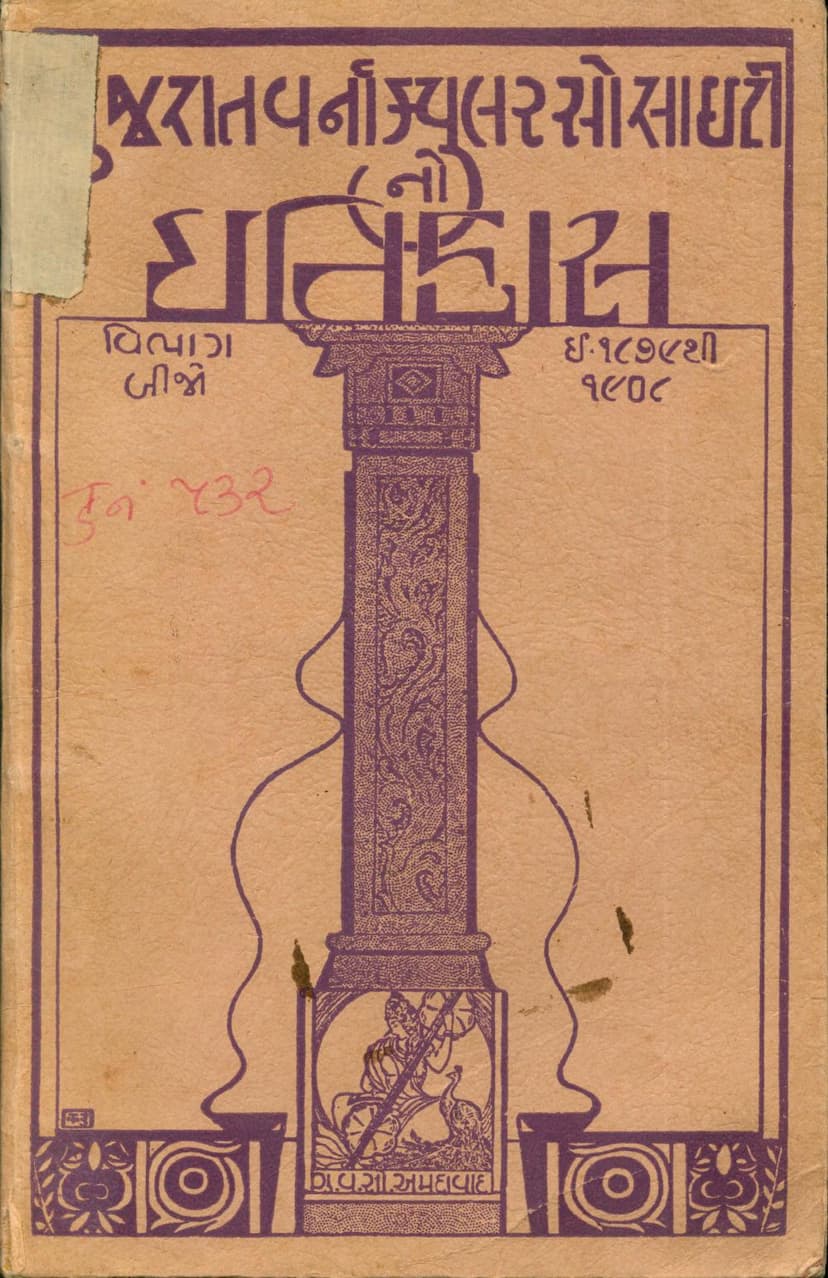Gujarat Varnacular Societyno Itihas Part 02
Added to library: September 1, 2025

Summary
The text provided is the second volume of the history of the Gujarat Vernacular Society, covering the period from 1879 to 1908. Authored by Hiralal Tribhuvandas Parekh and published by the same, it serves as a continuation of the society's historical documentation.
Here's a comprehensive summary of its key aspects:
Overall Purpose: This volume aims to chronicle the activities, achievements, and evolution of the Gujarat Vernacular Society during a crucial period of societal and educational transformation in Gujarat. It highlights how the society acted as a catalyst for literary, social, and educational progress, reflecting the changing landscape of the region.
Key Themes and Content:
- The Role of Literature in Social Change: The preface and introductory chapters emphasize literature as a reflection of life and a powerful tool for driving social change. The authors of the time, educated in new systems, identified shortcomings in education, social customs, and religious practices, using literature to guide public opinion and initiate foundational work (Spade work).
- Pioneering Efforts: The text celebrates the "Pioneers" who worked with dedication, tireless effort, faith, and courage to overcome obstacles and lay a strong foundation for national progress.
- Broad Scope of the Society's Work: Beyond social reform, the society actively engaged in economic and industrial improvements. Education and the cultivation of the Gujarati language and literature were central to its mission.
- Historical Context: The book delves into the broader historical context, including the impact of English rule, education, and culture on Gujarati life. It discusses the initial efforts of Christian missionaries in education and language development, the evolving public perception of these institutions, and the influence of Western thought and literature.
- Key Figures and Contributions: The volume details the contributions of prominent individuals associated with the society, such as:
- Mahipatram Rupram: His early life, reformist zeal influenced by his guru Durgaram Mehta, his controversial but pioneering trip to England, and his extensive involvement in public activities, including the Gujarat Vernacular Society, are highlighted.
- Bholanath Sarabhai: His lifelong association with the society, his role in the establishment of the Prarthana Samaj, and his philanthropic efforts are documented.
- Lalshankar Umiashankar: His significant role in building the society's infrastructure and his dedication to promoting education, especially female education, are emphasized.
- Other prominent figures like Ganesh Gopal Pandit, Krishnarao Bholanath Divetia, Harilal Harshadray Dhruv, Manilal Nabhubhai, and Damodar Das Moti Lal Parekh are mentioned for their contributions.
- Publications and Literary Endeavors: A significant portion of the book lists and describes the numerous books published by the society during this period, categorized by subject matter (history, biography, science, social reform, education, health, etc.). It notes the origins of these books (translations from Marathi, English, Bengali, or original compositions) and praises the efforts of the authors.
- Patronage and Financial Support: The text highlights the crucial support received from royal patrons like Maharaja Sayajirao Gaekwad of Baroda and Maharaja Shri Khangarji of Kutch, as well as from generous individuals and funds like the Sorabji Jamsetji Fund, Seth Harivallabhdas Bagavikas Fund, and Karandas Mulji Memorial Fund. The establishment of various trust funds by patrons is also detailed.
- Educational Reforms and Initiatives: The book discusses the society's role in advocating for vernacular education, the challenges faced in getting native languages included in university curricula, and the efforts made to promote female education. The establishment of girls' schools and the introduction of female teachers are noted.
- Social Reform Movements: The society's involvement in addressing social ills like child marriage, the encouragement of widow remarriage, and the condemnation of harmful customs is evident through its publications and advocated reforms. The text also touches upon the evolving religious thought, the rise of reformist movements like the Prarthana Samaj and Arya Samaj, and the impact of Western ideas on Indian society.
- The Society's Building: A significant part of the volume is dedicated to the acquisition and construction of the society's own dedicated building, detailing the challenges, fundraising efforts, and the eventual establishment of the "Premabhai Hemabhai Hall."
- Diamond Jubilee Celebration: The book extensively covers the Diamond Jubilee celebration of the society in 1909, detailing the various planned events, the messages of goodwill received, and the overall atmosphere of achievement and recognition.
- Critique and Future Vision: The text is not merely a celebration but also includes self-critique regarding the society's limitations, such as the need for original works rather than just translations, the importance of a comprehensive Gujarati dictionary, and the need for a standardized Gujarati orthography. The president's address at the Diamond Jubilee provides a forward-looking vision for the society's future activities.
Key Takeaways:
- The Gujarat Vernacular Society was a pivotal institution in shaping modern Gujarat's literary, educational, and social landscape.
- It served as a hub for intellectual discourse and the dissemination of knowledge, adapting to the changing times and embracing new ideas while preserving cultural heritage.
- The contributions of numerous individuals, from royal patrons to dedicated scholars and social reformers, were vital to the society's success.
- The volume emphasizes the interconnectedness of language, literature, education, and societal progress.
In essence, this second volume provides a detailed account of the Gujarat Vernacular Society's enduring legacy and its significant role in the cultural and intellectual awakening of Gujarat during the late 19th and early 20th centuries.